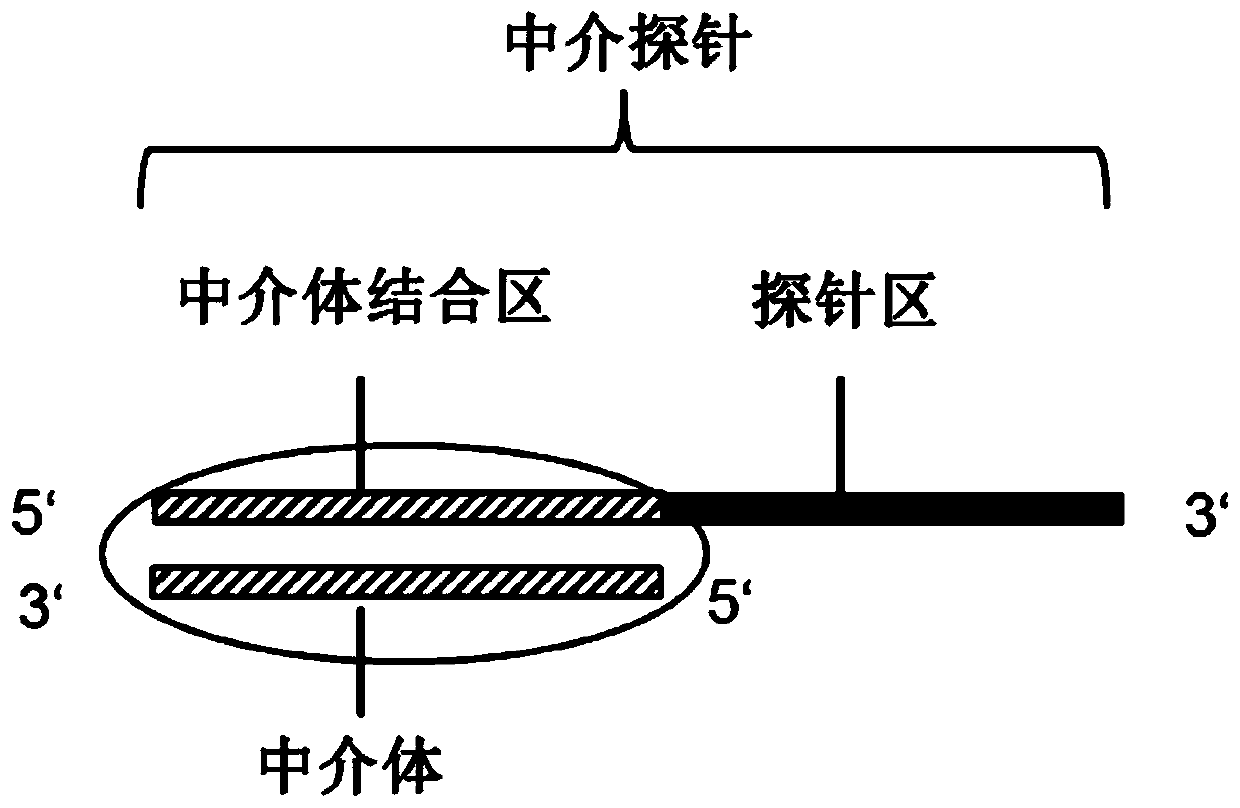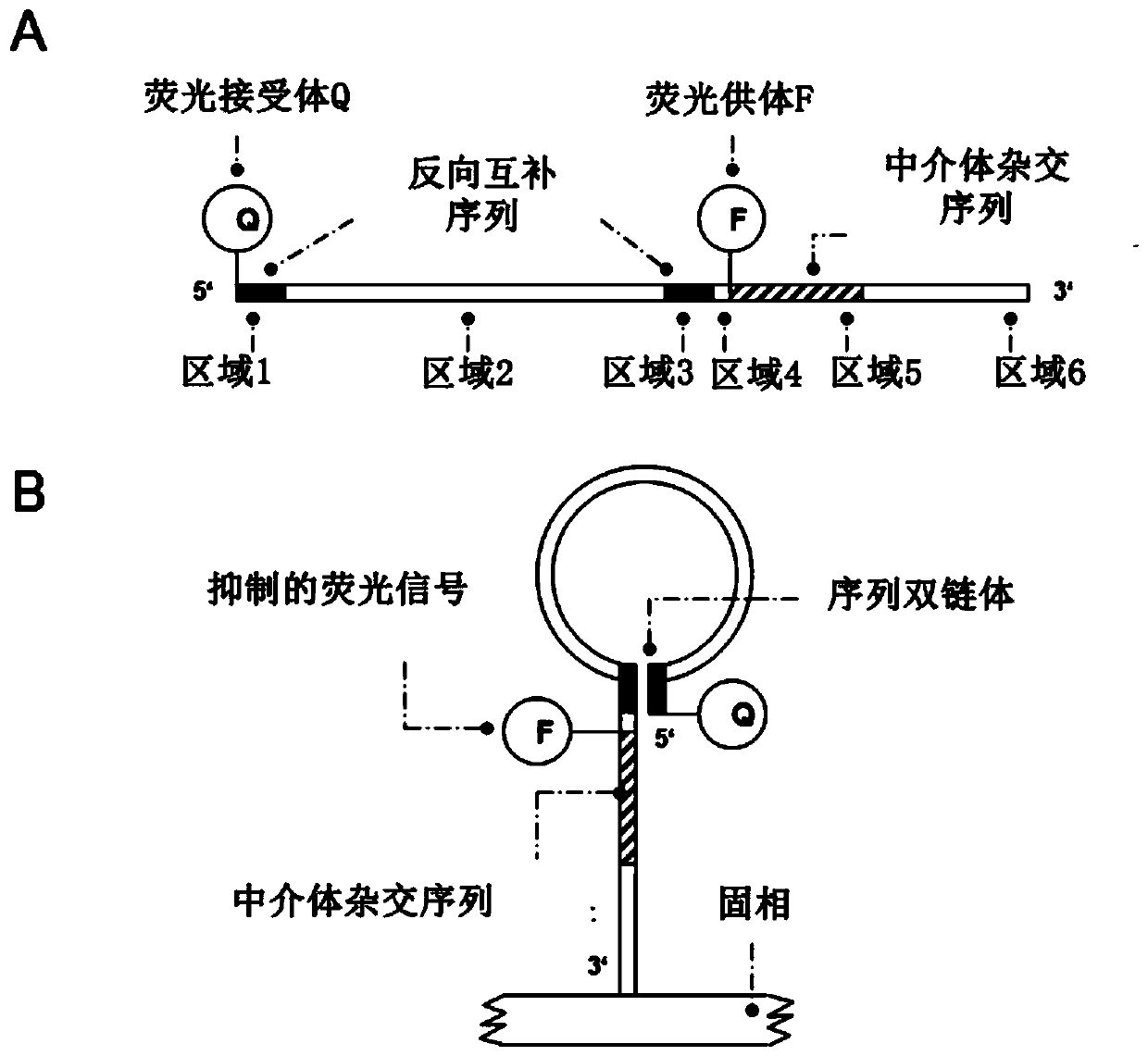Two-part mediator probe
An intermediary and probe technology, applied in the fields of biochemical equipment and methods, microbial determination/inspection, etc., can solve the problems of non-universal methods, a lot of work and time, and achieve the effect of simplifying primer design
- Summary
- Abstract
- Description
- Claims
- Application Information
AI Technical Summary
Problems solved by technology
Method used
Image
Examples
Embodiment 1
[0244] Example 1: Mediation Probe
[0245] Embodiments of the inventive design include an intermediary probe for detecting at least one target molecule, wherein the intermediary probe comprises at least two oligonucleotides. The first oligonucleotide has a Mediator binding region and a probe region. The Mediator binding region is located at the 5' end of the oligonucleotide and the probe region is located at the 3' end of the oligonucleotide. A second or several other oligonucleotides, a mediator or mediators, that chemically, biologically and / or physically bind to the mediator binding region of the first oligonucleotide . Mediators may consist of DNA, RNA, PNA or modified RNA such as LNA. The probe region of the first oligonucleotide has an affinity for the target molecule and / or the template molecule, and the mediator binding region has an affinity for a mediator or a plurality of mediators ( figure 1 ). A mediator or a plurality of mediators has an affinity for at lea...
Embodiment 2
[0246] Embodiment 2: the program of mediator replacement
[0247] After binding of the probe region to the target molecule and / or the template molecule, for example using a strand displacement polymerase, the Mediator is displaced by the Mediator binding region. This process can occur during the amplification of target molecules and / or template molecules. In an embodiment of the present invention, the probe region of the intermediary probe can be used as a primer in DNA amplification. After binding of the probe region to the target molecule and / or the template molecule, the intermediary probe is extended. A second primer can then be attached to the extended mediation probe and extended. During the amplification process, a mediator (mediator) or multiple mediators (mediators) are released from the mediator-binding region and trigger a detectable signal by interacting with one or more detection molecules ( figure 2 ).
Embodiment 3
[0248] Example 3: Detection Molecule with 6 Regions
[0249] The released, unlabeled mediator is detected with the help of a detection reaction. The reaction mechanism described below can be carried out in parallel with the amplification of target molecules and / or template molecules as described above.
[0250] In a preferred form of the invention, the detection molecule may consist of an oligonucleotide divided into six regions ( image 3 ). Region 1 includes the 5' end of the detection molecule consisting of the sequence segment and the fluorescent acceptor Q. Region 3 is the reverse complement of region 1 and is separated by region 2. Region 4 separates region 3 from region 5, and region 4 can specifically interact with Mediator molecules. Region 6 comprises a sequence region at the 3' end which may have chemical modifications and thus allow directional immobilization of oligonucleotides. Fluorescent donors F are associated in a suitable manner with the regions from re...
PUM
 Login to view more
Login to view more Abstract
Description
Claims
Application Information
 Login to view more
Login to view more - R&D Engineer
- R&D Manager
- IP Professional
- Industry Leading Data Capabilities
- Powerful AI technology
- Patent DNA Extraction
Browse by: Latest US Patents, China's latest patents, Technical Efficacy Thesaurus, Application Domain, Technology Topic.
© 2024 PatSnap. All rights reserved.Legal|Privacy policy|Modern Slavery Act Transparency Statement|Sitemap



